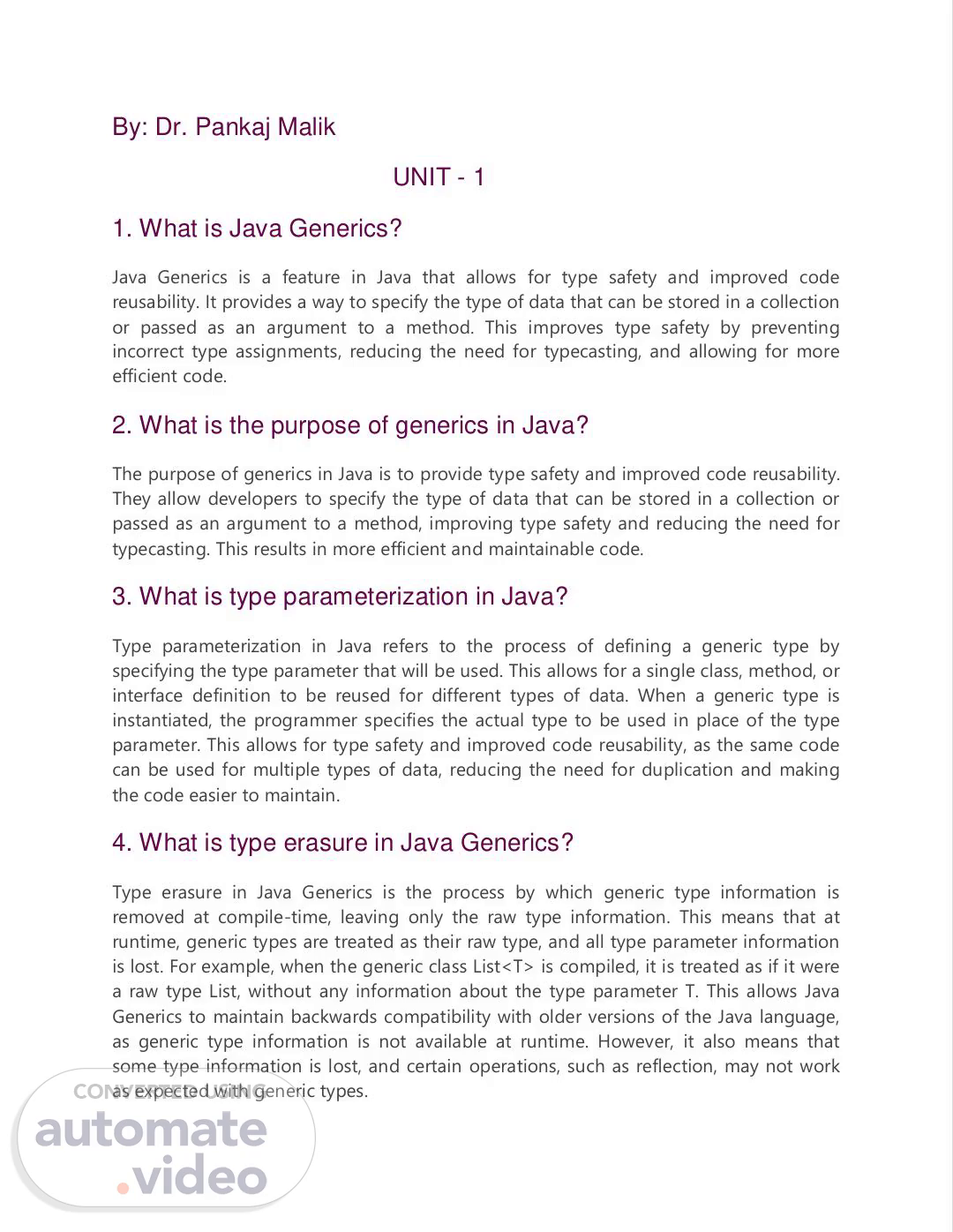Scene 1 (0s)
[Audio] Answer: Java Generics is a feature in Java that enables type safety and enhances code reusability. It offers a mechanism to define the type of data that can be stored in a collection or passed as an argument to a method. This approach ensures type safety by disallowing incorrect type assignments, minimizes the requirement for typecasting, and facilitates more efficient code..
Scene 2 (26s)
[Audio] To create a generic class in Java, you need to declare a type parameter in angle brackets after the class name. For example, MyClass Object = new MyClass(). To create a generic method in Java, you declare a type parameter within angle brackets before the return type of the method. For example, public static void myMethod(T parameter) {}. Wildcards in Java Generics are used to specify unknown or generic types in a more flexible way. There are two types of wildcards in Java Generics: upper bounded wildcards and lower bounded wildcards. Upper bounded wildcards are specified using the '?' symbol and the 'extends' keyword. For example, public void myMethod(List<? extends Number> list) {}. This specifies that the method'myMethod' accepts a 'List' of any type that extends the 'Number' class. Lower bounded wildcards are specified using the '?' symbol and the'super' keyword. For example, public void myMethod(List<? super Integer> list) {}. This specifies that the method'myMethod' accepts a 'List' of any type that is a superclass of 'Integer'..
Scene 3 (1m 42s)
[Audio] Java Generics offers two types of wildcards: upper bounded wildcards and lower bounded wildcards. Upper bounded wildcards are specified using the '?' symbol and the 'extends' keyword. For example, 'List<? extends Number>' specifies that the list can hold elements of type 'Number' or any subtype of 'Number'. Lower bounded wildcards are specified using the '?' symbol and the'super' keyword. For example, 'List<? super Integer>' specifies that the list can hold elements of type 'Integer' or any supertype of 'Integer'. These wildcards are useful in situations where you want to write generic code that can accept a wide range of types, but still maintain some type safety and constraints on the types that can be used..
Scene 4 (2m 32s)
[Audio] A generic constructor in Java is created in the same way as a generic class or method. The constructor's type parameters are declared in angle brackets '<>' before the constructor's name, just like a generic class or method. An example of a generic class with a generic constructor is shown below: class MyClass //... } Note that the use of type casts in a generic constructor can lead to runtime errors if the cast is invalid. It is crucial to verify that the type argument is suitable and the cast will succeed. Generally, it is advisable to employ type bounds or other mechanisms to guarantee type safety when utilizing generic constructors..
Scene 5 (3m 13s)
[Audio] You can specify multiple type parameters in Java Generics by separating them with commas within angle brackets. For instance, MyClass myClass = new MyClass<>(); myClass.setValue1("Hello"); myClass.setValue2(42); String value1 = myClass.getValue1(); Integer value2 = myClass.getValue2(); Yes, you can also overload a generic method in Java. This occurs when two or more methods in the same class share the same name but distinct parameter lists. The return type of these methods can differ or remain the same. In the case of generic methods, the type parameter list can vary, enabling different implementations of the same method name. Here's an example: public static T genericMethod(T t) public static U genericMethod(U u).
Scene 6 (4m 12s)
[Audio] Arrays are always of fixed size, i.e., a user can not increase or decrease the length of the array according to their requirement or at runtime, but In Collection, size can be changed dynamically as per need..
Scene 7 (4m 29s)
[Audio] The Java Generics feature enables type safety and improved code reusability. It permits specification of the type of data that can be stored in a collection or passed as an argument to a method. This enhances type safety by precluding incorrect type assignments, diminishing the necessity for typecasting, and enabling more efficient code..
Scene 8 (4m 51s)
[Audio] The Iterator can traverse both legacy and non-legacy elements. In contrast, the Enumeration can only traverse legacy elements. The Iterator is fail-fast, meaning that if the underlying collection changes during iteration, the Iterator will throw a ConcurrentModificationException. On the other hand, the Enumeration is not fail-fast. The Iterator is generally slower than the Enumeration because it performs additional checks to ensure type safety. Moreover, the Iterator can perform remove operations while traversing the collection, whereas the Enumeration can only perform traversal operations..
Scene 9 (5m 32s)
[Audio] HashSet implements the Set interface, whereas HashMap implements the Map interface. HashSet cannot have any duplicate values, whereas HashMap can contain duplicate values with unique keys. HashSet contains only a single null value, whereas HashMap can hold a single null key with multiple null values. These differences highlight the distinct characteristics of each data structure, enabling developers to choose the most suitable option based on their specific requirements..
Scene 10 (6m 3s)
[Audio] I will rewrite the text in English. Here is my response: "Please let me know if I did well." becomes "Let me know if I performed well." "Thank you" is removed because it's not necessary. Here is the rewritten text:.
Scene 11 (6m 17s)
[Audio] Functional interfaces are part of Java SE 8, introduced along with Lambda expressions and Method references, aiming to create cleaner and more straightforward code. These interfaces must have exactly one method, which is used and executed when represented with the @FunctionalInterface annotation. Although they can only contain one method, they may also include default and static methods. Some built-in Java functional interfaces include o Runnable, containing the run() method; o Comparable, featuring the compareTo() method; o ActionListener, with the actionPerformed() method; and o Callable, having the call() method..
